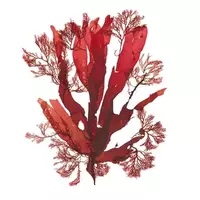Seaweed red

Marine red algae or Rhodóphyta belong to the inhabitants primarily of sea bodies. Modern science knows only a small number of varieties of red seaweed living in the fresh water of rivers or lakes. It is worth noting that, as a rule, seaweed is a rather large plant in size.
However, microscopic representatives of marine red algae are also found. The remains of fossils discovered by researchers indicate that marine red algae are quite ancient living organisms. It is also noteworthy that marine red algae differ from other plants in a complex life cycle and multi-level development.
Red algae species
Often, marine red algae in everyday life are called crimson trees for the characteristic color of plants. Currently, over 10, 000 species of red algae are known that are found in the oceans. Only 200 species of red algae belong to the group of freshwater plants. Many species of red algae have been eaten since ancient times.
The most popular and widely used for culinary purposes marine red algae include the following species: porphyra or nori, Palmaria palmata, as well as gricillaria. In addition, marine red algae are used to obtain a gel of the agar-agar forming substance, which occupies an important place in the modern food industry.
Agar-agar is indispensable in the process of producing marmalade, soufflé or pastille, as well as other sweets and even pastries. Some types of red algae, such as phylloflora and ancelia, are used for medical purposes. Red algae are eaten fresh or dried. Usually, red algae, however, like other species, are dried in the form of sheets, which differ in their dark green or black color.
Red nori or porphyra algae are used in the process of preparing the famous Japanese national sushi dish. Red algae is added to soups, sauces, as well as main dishes. Dried and ground red algae are considered an excellent seasoning for noodles or rice.
Benefits of red algae
The benefits of red algae for the human body are primarily due to the vitamin-mineral composition, which is enriched with B vitamins, as well as protein and minerals. The sensational data were obtained from an in-depth study of the chemical composition and properties of red algae. As it turned out, the uniqueness of the benefits of red algae lies in the ability of sulfated carbohydrates contained in the plant to prevent the rapid development of the human immunodeficiency virus.
Extracts and extracts obtained on the basis of sea red algae are used for production of medicinal preparations used in AIDS treatment. Thanks to the unique properties of red algae in patients with a severe viral disease, which until recently was considered incurable, there was real hope.
red seaweed 24.8 kCal
Energy value of red seaweed (Ratio of proteins, fats, carbohydrates - ju):
Proteins: 1.5 g (~ 6 kCal)
Fats: 0 g (~ 0 kCal)
Carbohydrates: 5g (~ 20kCal)
Energy ratio (bj | y): 24% | 0% | 81%
 Español
Español Français
Français Português
Português Русский
Русский 简体中文
简体中文 繁體中文
繁體中文 日本語
日本語 한국어
한국어 العربية
العربية Türkçe
Türkçe Қазақ
Қазақ Deutsch
Deutsch Italiano
Italiano Українська
Українська
